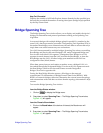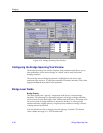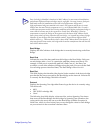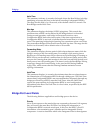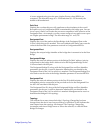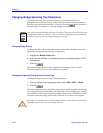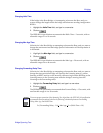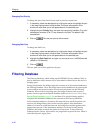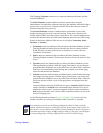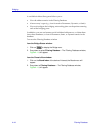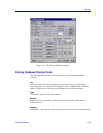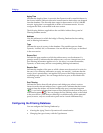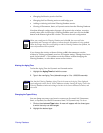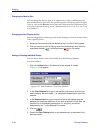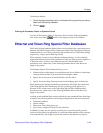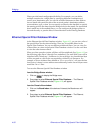
Filtering Database 4-43
Bridging
The Filtering Database consists of two separate databases: the Static and the
Learned Databases.
The Static Database contains addresses that are entered by a network
administrator. You add these addresses directly to the database while the bridge is
powered up, or to the deviceÕs battery-backed RAM so that they are stored on
shutdown until the next power-up.
The Learned Database consists of addresses that accumulate as part of the
bridgeÕs learning process as it is up and running. These do not remain in the
Source Address Table when the system is shut down. The Learned Database also
contains the addresses that are in the Static Database upon start-up of the bridge.
Entries to the Source Address Table are one of four types: Permanent, Static,
Dynamic, or Learned.
¥ Permanent entries are addresses that you add to the Static Database (via the
Filtering Database window) that are stored in the deviceÕs battery-backed
RAM. Since they remain in the device on shutdown or restart, they are
considered ÒPermanent.Ó
¥ Static entries are addresses that you add to the Static Database (via the
Filtering Database window). These entries remain in the device until it is shut
down.
¥ Dynamic entries are addresses that you add to the Static Database (via the
Filtering Database window). With the Aging Time feature, you set the time
period that these addresses are saved in the Source Address Table. Addresses
that have not transmitted a packet during one complete cycle of the aging
timer are deleted from the database.
¥ Learned entries are addresses that are added to the Learned Database through
the bridgeÕs learning process. With the Aging Time feature, you set the time
period that these addresses are saved in the Source Address Table. Addresses
which are inactive within a cycle of the aging timer are dropped from the
database.
Learned address entries are divided into two types, Learned and Self. Address
entries classiÞed as Learned have transmitted frames destined for a device
attached to a device portÕs connected segment. Address entries classiÞed as
Self are those that have sent a frame with a destination address of one of the
deviceÕs bridging ports.
At the Filtering Database window (Figure 4-11, page 4-45), you can view the
number of entries of each type: Permanent, Static, Dynamic, or Learned.
NOTE
Even though new entries into the Filtering Database are added as Static entries by
default, note that some devices, including the FN100, do not support Static entries. For
these devices, once you add an entry into the Filtering Database, it must be changed to a
Permanent type before clicking on OK to apply the change. If the entry is not changed to
a Permanent type before clicking on OK, you will receive a Set Failed message.



